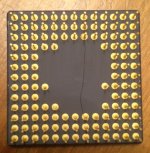apm
Well-known member
Question for the experienced debuggers here: on the SE/30, what are the first things the 68030 does when powered up, and what are the best signals to test to work out early startup problems?
A while back I bought an SE/30 logic board (socketed) which had been recapped but was still nonfunctional: horizontal stripes, no signs of life. I'm testing it in a machine with a known working analog board. There's nothing obviously wrong with the recapping job on visual inspection. Since UB11 is a known failure point, I removed it. No change. I also swapped the ROM SIMM with no change.
At that point I started poking around with a scope. I can confirm the RESET/ line is high and the 16MHz clock is present on the 68030. But I couldn't find any activity on any of the address or data pins, though admittedly I didn't test them all.
Rather than stabbing around randomly, can anyone explain the very first signs of activity to look for on the logic board?
A while back I bought an SE/30 logic board (socketed) which had been recapped but was still nonfunctional: horizontal stripes, no signs of life. I'm testing it in a machine with a known working analog board. There's nothing obviously wrong with the recapping job on visual inspection. Since UB11 is a known failure point, I removed it. No change. I also swapped the ROM SIMM with no change.
At that point I started poking around with a scope. I can confirm the RESET/ line is high and the 16MHz clock is present on the 68030. But I couldn't find any activity on any of the address or data pins, though admittedly I didn't test them all.
Rather than stabbing around randomly, can anyone explain the very first signs of activity to look for on the logic board?

